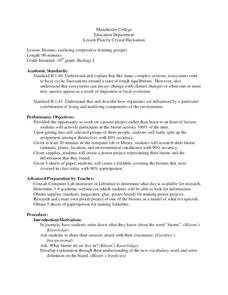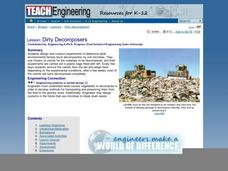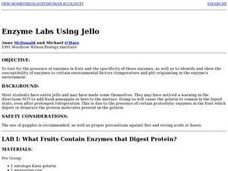Curated OER
Cloudy with a Chance of Meatballs
Students explore the 5 themes of geography. In this cross curriculum literacy and geography lesson, students listen to Cloudy with a Chance of Meatballs by Judi Barrett, and make a list of the needs of the people in Chewandswallow....
Curated OER
Soybeans: The Miracle Seed
Students discover why soybeans are called the "miracle seeds." They make their own soynuts and share other foods made from soybeans. They create a bulletin board of soybean products.
Curated OER
Environmental Limitations
Seventh graders study the environmental factors that affect population growth. In this biology lesson, 7th graders create a city following certain criteria. They present their posters in class.
Curated OER
Terrestrial Hi-Lo Hunt
Students assess environmental factors. In this environmental factors lesson, students explore their surroundings identifying warm and cool spots, dry and wet areas, and determining the warmest and coolest areas. Students analyze their...
Curated OER
Planets in a Bottle
Students experiment with yeast. In this environmental conditions lesson students test the viability of samples of yeast. Students investigate the effects of environmental conditions on the yeast.
Curated OER
Biomes
Tenth graders research locations of biomes and their barriers. In this biomes lesson, 10th graders examine location, environmental conditions, and species of plants and animals that live in the biome. Students take notes and create a...
Curated OER
Soil Permeability
Students discuss how soil permeability is affected by permafrost. In this soil lesson plan, students freeze soil over night, and discuss how the environmental conditions of freezing affect soil and further affect vegetation.
Curated OER
Temperature Affects The Heart Rate
Students relate heart rate and development to environmental conditions through experiment. In cooperative groups, students record the heart rate in developing zebra fish. Groups create a standard curve to predict the temperature at...
Alabama Learning Exchange
How Old Is That Tree?
Fifth graders study environmental changes by examining the annual rings of a cross-section of a tree trunk. They access websites to complete a worksheet on the parts of a tree. They count the annual rings on a tree slice while observing...
Michigan Sea Grant
Environmental Decision Making
Pupils participate in a board game activity in which landing on a space called "Decision Card" presents them with a land-use situation to consider and decide how to act. In order to advance in Hydropoly, players must think critically and...
Curated OER
Where Creatures Live
Young scholars discover that the environmental conditions of a place determine the types of plants and animals that live there.
Curated OER
Magic Hat How-To
Students research and investigate photographs of various environmental conditions of a desert, rain forest or high mountain peak and then design and decorate a magic camouflage hat especially for that region. They also determine how they...
Curated OER
Flowering Phenology: How Do Plants Know When to Flower?
Students study the process of plant reproduction and the biotic and abiotic factors that affect flowering phenology. In this plant reproduction instructional activity, students describe the interaction of environmental factors as it...
Curated OER
Plants Around a Building
Students discover environmental factors of plant growth. In this environment lesson plan, students read action cards describing various environmental factors. Students then search to find an example of the situation listed on the action...
Curated OER
Control of the Cell Cycle
In this cell cycle worksheet, students will study genetic factors and environmental factors that affect the cell cycle. Students will use this idea map to complete 4 short answer questions.
Curated OER
Dirty Decomposers
Seventh graders design and conduct experiments to determine what environmental factors favor decomposition by soil microbes. They use chunks of carrot for the materials to be decomposed, and their experiments are carried out in plastic...
Curated OER
Sun and Temperatures
Students consider the relationship of temperature to environmental conditions and then apply their knowledge to a practical event. The task assesses students' knowledge and application of that knowledge to an additional situation.
Curated OER
Enzymes and Jell-O
Students test for the presence of enzymes in fruit and the specificity of those enzymes. They identify the susceptibility of enzymes to certain environmental factors such as temperature and pH in the enzymes environment.
Curated OER
Shining the Light on Skin
Students investigate the relationships between certain environmental factors and levels of exposure to sunlight. The variables of location, time of year, and day, and the weather which affect the intensity of the sun are explored in this...
Curated OER
Individual and Environmental Factors Affecting Food Systems and Choices
Learners study the environmental factors that affect food systems and choices. In this food systems and health lesson, students study global and national information about obesity. Learners study photos and captions about the topic....
Curated OER
Optimal Foraging
Students participate in a foraging activity that demonstrates environmental conditions playing an important role in determining the optimal foraging behavior of a particular organism.
Curated OER
A Tale of Two Cranes How Do Wild and Costume-raised Whoopers Compare?
Students explore what young cranes need to do to survive.
TeachEngineering
Teach Engineering: Cellular Respiration and Population Growth
Two lessons and their associated activities explore cellular respiration and population growth in yeasts. Yeast cells are readily obtained and behave predictably, so they are very appropriate to use in middle school classrooms. In the...
TeachEngineering
Teach Engineering: Population Growth in Yeasts
This lesson is the second of two that explore cellular respiration and population growth in yeasts. In the first lesson, learners set up a simple way to indirectly observe and quantify the amount of respiration occurring in...

























